
Hitting plateaus is painful, but it happens to everyone.
I’ve been producing music for the last 11 years. There are still times I begin a new track, work on it for a week straight and make serious progress. At that point, I’m a happy camper.
Then, crickets.
I become frustrated and try to force my way out of it because it feels like it’s my fault — it's a tough thing to handle.
Ok, but how does that relate to email lists?
Growing an email list doesn't have to be complicated.
There may be times that your email list’s growth slows down. And when you manage to overcome it, another plateau may hit. It will feel like it’s your fault that this is happening.
But it’s not your fault; you’re just doing the same thing that got you to 1,000 email subscribers in hopes to get to 5,000.
If you’re currently experiencing a similar situation with slow email list growth or want to be proactive, this article will help you find things you can do today to get through it.
Why does my email list grow slow?
There’s no short answer to this question, but could happen because of one or a combination of factors:
- The email content is uninteresting
- A narrow range of covered topics
- It's not easy for users to subscribe
- You’re asking for sign ups at the wrong time and place
- People don't understand the value of subscribing
- No incentive for subscribing
Here are some ideas that might inspire new options to explore to grow your email list.
How to overcome slow email list growth
There are three things you can do today to overcome your email list’s slow growth:
- Improve the content you produce
- Improve the ways you collect email addresses
- Run a newsletter referral program
Improve the content you produce.
When you’re producing content, there are four rules you need to follow:
Rule #1: Make it easy to skim
A staggering 43% of people admit they skim blog posts. So if you want people to read your articles or newsletters, you need to make sure it's easy to skim.
Check out this example from flickr, would you read that?

If you want people to read your newsletters or articles you need to break out important section with images, graphs, headers, bullet points, bold or underlined font, and more. Make it easy for readers to quickly digest your most important points.
Rule #2: Deciding who you’re creating the content for
Think about it in a higher level: Are you producing the content for humans or search engines?
This decision is going to have a significant impact on how you do things.
If you’re a newsletter business, you probably don’t care about SEO because it’s not an active distribution channel for your business. But some businesses rely on organic traffic to grow their email lists — including AWeber.
Remember this list you read?
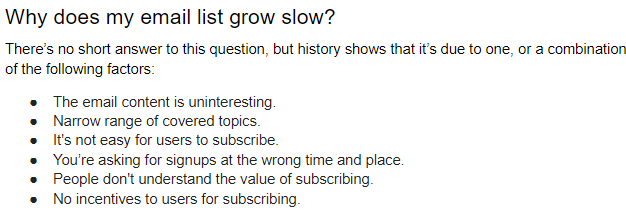
It’s a question in H2 heading format, plus a short paragraph and unordered list items.
We used that format because it’s the optimum format for becoming Google Feature Snippets.
Ideally, when someone googles “Why does my email list grow slow?” the search engine will serve the list as an answer.
Here's an example of how that looks:
If you google “how can I be happy?”, you’ll get the following result:
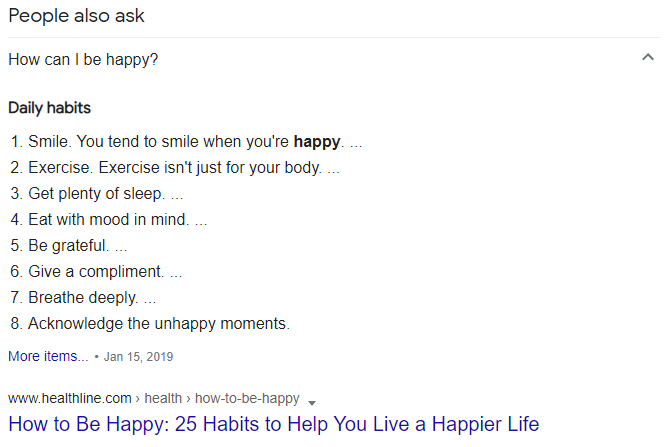
Writing for humans requires a different skillset, though.
People will join you and stick around if you’re consistently providing them content that brings them closer to their goals, educates them, or simply entertains them.
Rule #3: Write with a mission
Think of a mission statement you can include in most of your content. It has to be a mission you believe in, and one that will resonate with your ideal audience — ideally, other people who believe in that mission.
A great example is theDONUT. Recently, their CEO talked with Dimitris Tzortzis (Head of Product at Viral Loops) to explain their mission.
theDONUT wants to offer unbiased news coverage. Their daily newsletters include news facts, with links to sources covering the fact from different perspectives.
Here’s how it looks:
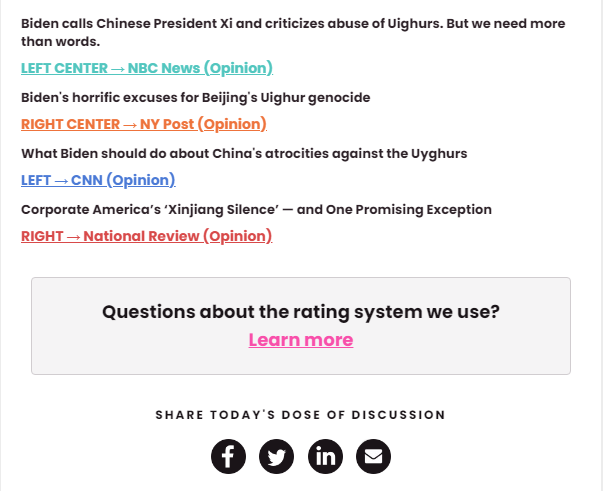
Peter (theDONUT’s CEO) is a human being, and as a human being, I’m sure he has his own opinion biases.
But he wants to build a world where news organizations are less biased and at the same time become less biased himself.
He turned his personal mission into his company’s mission, and their audience appreciates and endorses it.
Rule #4: Improve how you collect email addresses
There's tons of ways to collect more email addresses. But here's a summary of what you should do:
- Build a landing page
- Use exit-intent pop-ups
- Offer gated content
- Organize virtual events
Some of the options seem apparent, but you’d be surprised how much room for improvement there is.
Landing pages
Creating a landing page dedicated to capturing newsletter subscribers allows you to communicate more information about the content you send, or your mission statement, or really anything that will make someone want to subscribe.
AWeber has a newsletter dedicated to email marketing— FWD: Thinking. Here’s the landing page page for this particular newsletter.
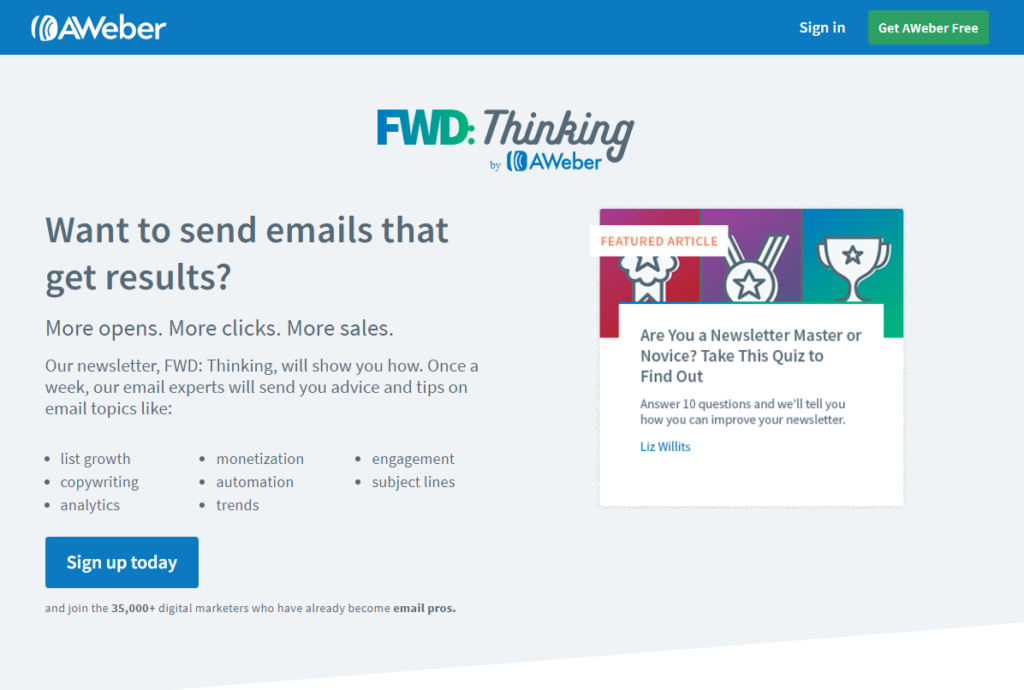
Plus, if you want to segment your list in the future to give subscribers personalized information, landing pages with tag support are a must.
Segmenting your email lists helps keep the user engagement high.
A highly engaged list will generate more email subscribers in the long run simply because people like to speak about things they find fascinating.
But until word-of-mouth kicks it, you can use landing pages as a magnet for subscribers and an opportunity to showcase your manifesto.
Exit-intent pop-ups
If you have a blog without an exit-intent pop-up, you might be failing to capture the email addresses of +5% of your traffic.
Sumo wrote an extensive guide about exit-intent pop-ups, but here are some things that will increase the conversion rate of your pop-ups:
- Serving a pop-up in the proper context.
- Not showing the pop-ups immediately.
- Using a headline with a clear message.
- Using the pop-up to showcase your personality.
- Offering something of value in exchange for an email address.
- Matching the call to action with the offer.
Gated content
Gated content is an online asset (like ebooks, videos, research papers) that requires users to give their email addresses before accessing them.
Here’s an example from Backlinko:
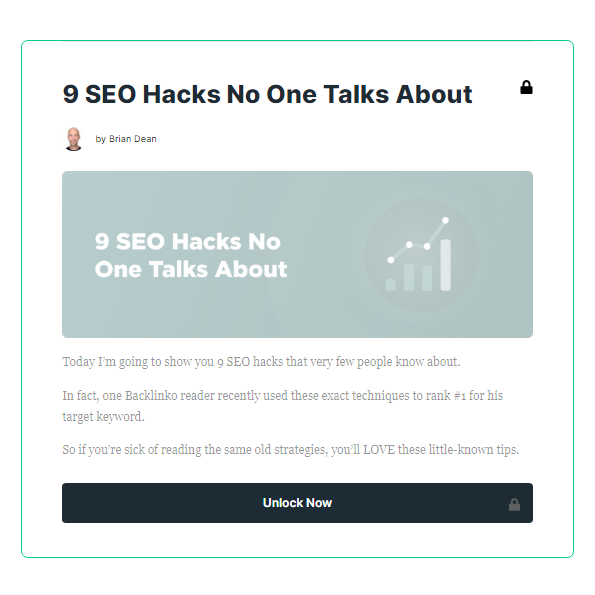
Apart from the obvious use (as an email capturing mechanism), gated content could be a valuable tool for getting more information about your subscribers before even entering your email list.
Virtual events
It was about a year ago that the COVID outbreak made its way into our lives. Almost everybody started relying more on online communication systems — students attended online classes, white-collar workers operated from their homes, and musicians performed live concerts with no audience.
Whether you’re a SaaS company or a nutrition blog, virtual events offer an opportunity to minimize the cost of connecting with a broader audience.
Picture this: You run a music blog, and you organize a virtual concert with Beyonce that people can attend in exchange for their email addresses.
Maybe you don’t have a few million dollars to pay for a performance, but it’s not the point.
The point is that you can organize and host events that people can watch from home wearing their PJs. Also, having guests at your virtual event gives you access to their audience, making the top of your funnel broader.
Run a newsletter referral program
Social media and search engine algorithms drown the voices of millions of creators, writers, and journalists. That's why email newsletters are key — they let people easily keep in touch with their audience.
In recent years, creators and publishing companies started using newsletter referral programs to reach their goals cost-effectively.
Some of the most famous examples of publishing companies using referral programs to grow their audience are:
- TheHustle
- MorningBrew
- TheSkimm
- The Gist
The Gist uses a multi-tiered rewarding system for successful referrals.
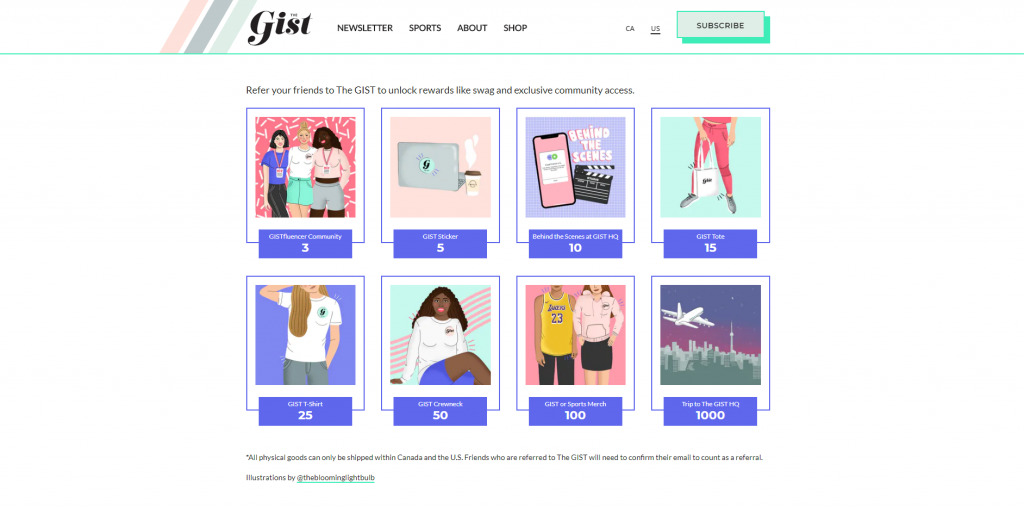
Offering multiple rewards ensures that your subscribers have many goals to reach; thus, they will share their referral links more.
If you’re wondering what kind of rewards to offer in your newsletter referral program, here’s a quick list:
- Access to private communities
- Free membership
- Access to an exclusive newsletter
- Merchandise and company swag
- Early access to new product features
- Internal currency (Dropbox used internal currency as a reward for referrals)
- Trips to meet you and your team
Even though the choice of referral rewards is only limited by your imagination, there are three things you should keep in mind:
- Your referral rewards should align with what your brand represents.
- Pick rewards that reinforce your product’s experience.
- Only consider a reward system if people already enjoy your product.
The last item on the list above is of high importance; it will save you from building a referral program that doesn’t benefit your company and keep you from spending money that you don’t have to spend.
TheDONUT checks all the boxes, offering branded rewards that fit the vibe the company promotes.
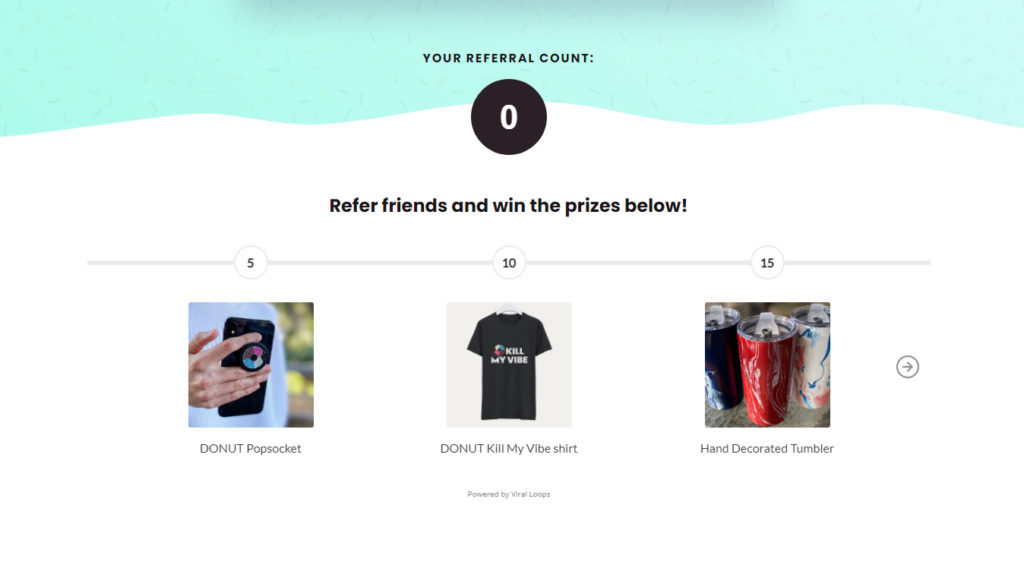
- 5 referrals = DONUT popsocket
- 10 referrals = DONUT t-shirt
- 15 referrals = Hand decorated tumbler
Nothing too fancy, but their readers love it.
If you want to learn more about building, running, and improving your newsletter referral programs (including choosing rewards), I suggest you read the Actionable Guide for Newsletter Referral Programs.
You can create a newsletter referral program that works from inside the newsletters you send to your subscribers, using AWeber and Viral Loops.
Here’s how:
In summary
It’s possible for an email list to stop growing at some point. The first thing you need to do is to change your perspective on how you do things.
The things that took you from A to B may not get you from B to C.
Document the problems you find in what you do. Then try to come up with solutions that resonate with your company’s mission and current stage.
It’s a process that takes time with a lot of trial and error.
However, there are three things you can do today to overcome your email list’s slow growth:
- Improve the content you produce.
- Improve the ways you collect email addresses.
- Run a newsletter referral program.
Combining the things mentioned in this article will help you get out of the situation, grow your email list, learn more about your business, and— why not, yourself.
The post 3 Ways to Overcome Slow Email List Growth appeared first on AWeber.
from AWeber https://ift.tt/32WNjwQ
via IFTTT
No comments:
Post a Comment